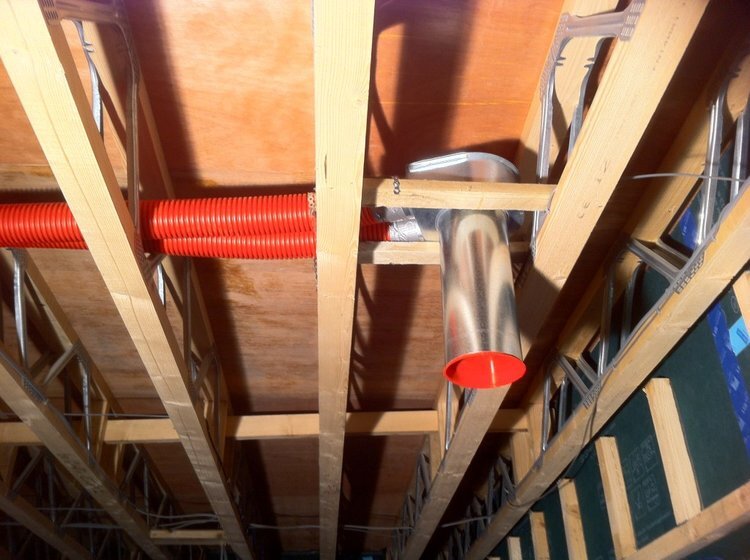Crawfordsburn Diary Entry No.19 - Ventilation (MVHR)
The ventilation system, with heat recovery, is an integral component of the dwelling, essential for achieving the Passivhaus certification performance levels. A proven low-energy and highly efficient ventilation method, MVHR is fast becoming the most common method of whole home ventilation for new build properties. MVHR systems allow for heat recovery of expelled stale air and comfortable ventilation to all areas of the house. MVHR systems will quietly and efficiently provide the home with warm filtered air in cooler months, and cooler filtered air in summer, improving the indoor air quality and reducing dust and allergen levels. Ducting from the MHVR system connects to each room of the house, with either extract or supply; these ducts then pass through the Paul Novus 300 heat exchanger. The following photograph illustrates the Paul Novus 300 heat exchanger, as installed in the first floor services storeroom.
Mechanical Heat Recovery & Ventilation unit (MVHR)
The building airtightness is essential for the MVHR to run efficiently, Passivhaus certification requires a building to have an airtightness of a maximum of 0.6 air changes at 50 Pascals. As a general rule, MVHR starts to become economically and environmentally effective when airtightness levels are less than or equal to 3 air changes at 50 Pascals.
When choosing an MVHR unit we decide to opt for a model which had been tested and approved by the Passivhaus Institut. This allowed us to input the efficiency levels directly into the Passivhaus Planning Package (PHPP) software. Units that have not been certified by the Passivhaus Institut get a 12% efficiency penalty as the manufacturers claims have not been stringently tested by the Institut.
After much research we decided to use a Novus 300 unit, manufactured by Paul. This MVHR unit has an effective heat recovery rate of 93%. The system was installed this week at the Crawfordsburn passive house, with the heat recovery unit being housed on the first floor, within its own purpose built store.
The ducting system, which transports and supplies air throughout the dwelling, has to be designed, installed and subsequently commissioned to give an equal supply of air both in and out. If this does not occur the MVHR efficiency will by considerably affected. For passive house building a minimum airchange rate of 0.3 times the dwelling volume per hour is judged to be the rate required to offer a healthy comfortable environment with minimal heat loss.
The MVHR system that has been installed supplies air to the ‘dry’ areas such as living, bedrooms and study, and extracts air from the ‘wet’ rooms such as kitchen, utility and bathrooms. Hallways and landings are utilised for the air to move from the supply to the extract. It is vital that all doors have a small 15mm gap to the bottom to ensure the flow of air from room to room.
In this passive house the MVHR ducting system is embedded within the dwelling fabric, hence why it needs to be taken into consideration right from the beginning of the design process. Retrofitting is possible but it typically requires unsightly boxing and tends to be a more expensive installation process.
When deciding on a first floor construction type our decision was influenced by the MVHR system, as the floor joists we chose allow the ductwork to be neatly concealed. The following photographs illustrate the ducting installation.
The floor void services
Ducting shown in the floor space
There are a few common misconceptions about MVHR systems, which we want to address, the first one being that they are noisy. It can be true that ill designed ducting will result in air turbulence and therefore noise and sound transference between rooms. Well designed ducting, such as that in the Crawfordsburn passive house, will use varying sizes of ducts to balance air flows and have “attenuators” (silencers) installed at strategic places, to prevent noise.
The other misconception is that the occupants cannot open windows in a Passivhaus dwelling. If the MVHR system is correctly installed the need to open windows is indeed lessened as air quality is improved. However, the occupants can of course open windows, as in any other dwelling.
The passive house ventilation system is bringing in adequate levels of cold air and warming it up through the heat recovery ventilation. Because cold air can carry very little moisture and warmer air can carry more, this means that the warmed air will tend to have a rather lower humidity and that ensures less humid air throughout the dwelling. What this means is that Paddy and Helen can have plenty of plants to humidify the air and of course that their wet towels won't be much of a problem!
Passivhaus design standards generate uniform interior temperatures with the consistent ventilation. When this is compared to the ‘typical’ dwelling, in which ventilation is usually pretty inconsistent, the lowest levels of ventilation tend to be on the cold days. This can accentuate mould and damp as people are reluctant to open windows or even trickle vents when it is cold.
The ventilation unit can be controlled by a digital panel which has been installed in a downstairs store. This offers the occupants full control over the internal environment, if the temperature get too warm in the summertime, for example, then literally a touch of a button can cool it down again. It also has a useful ‘boost’ function which speeds up the fan speed, especially useful if the owners have a party!
Control Panel for MVHR
In the next entry will discuss in more detail the hot water and space heating installations and how they are intrinsically linked to the dwelling ventilation.




